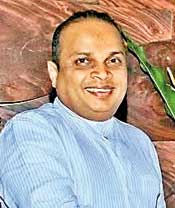Sports Tourism, a potential sector neglected by Sri Lanka

Chandana Amaradasa
From being the fifth-oldest country to play rugby to being home for some of the world’s most historic golf courses, the country has a story waiting to be told. However, systemic inefficiencies and lack of infrastructure have kept these accomplishments from translating into economic gains.
“Despite its rich sporting history, Sri Lanka has failed to capitalise on the opportunities sports tourism presents,” Chandana Amaradasa, the Managing Director of Island Leisure and Sri Lanka Cricket’s hospitality partner for the upcoming series laments, adding that the lack of proper facilities and strategic focus has been a major deterrent.
Golf, a major global industry, is underutilised in Sri Lanka despite having some of the world’s oldest courses, such as those in Colombo (146 years old) and Nuwara Eliya (over 136 years old).
“Golf, a billion-dollar industry worldwide, remains underutilised in Sri Lanka despite its historic courses,” notes Amaradasa.
Seeking to change this, they recently hosted Peter Walton, the CEO of International Association of Golf Tour Operators, who was astounded by the island’s golfing history. Walton emphasised that with proper marketing and the development of golf clusters akin to Turkey’s, Sri Lanka could carve out a significant niche in the global golfing industry. Cricket, Sri Lanka’s flagship sport, faces challenges due to a shortage of grounds. Most facilities are concentrated in Colombo and are overbooked for various tournaments, leaving limited opportunities to attract international teams.
“The focus should shift to developing basic, well-maintained grounds in areas like Kalutara, Galle, Kandy, and Dambulla, which also have tourist infrastructure,” he said, adding that improved facilities can draw international cricket clubs, schools, and associations, enhancing revenue streams. He also believes sports like hockey, rugby, and football present untapped opportunities.
“The hockey facility in Matale, for instance, requires significant upgrades, while rugby—thriving in Colombo and Kandy—could attract teams from major rugby nations with improved facilities. Football, once a prominent sport in the 1980s, has faded,” he asserted, adding reviving it through grassroots initiatives and better infrastructure could yield substantial economic and cultural benefits.
Countries like Dubai and Singapore serve as prime examples of sports tourism success. By investing in world-class facilities for events such as Formula One and international cricket, they have drawn global attention and significant revenue.
“Sri Lanka, with its abundant land and natural beauty, could replicate these successes,” Amaradasa suggested.
A Formula One track in Colombo, for instance, could elevate the city onto the global events calendar, attracting thousands of spectators annually. Realising this vision requires robust public-private collaboration. Amaradasa advocates for the government to focus on creating an enabling environment—facilitating approvals, utilities, and tax incentives—while leaving investment and management to private entities.
The neglect of sports tourism in Sri Lanka’s overall tourism strategy is a glaring oversight. Amaradasa laments the lack of recognition for this segment, even in prestigious events like the Presidential Tourism Awards.“There isn’t even a single comprehensive document outlining efforts to promote sports tourism,” he remarks.
To unlock its potential as a sports tourism hub, Sri Lanka needs visionary leadership and a unified strategy. Amaradasa suggests forming a Presidential Task Force to spearhead bold decision-making and ensure meticulous implementation. Public-private partnerships, modelled after Dubai’s successful initiatives, could be instrumental.“Tourism is the world’s largest industry,” Amaradasa concluded.
“For Sri Lanka to harness its potential, it must focus on developing high-quality experiences. Enhancing average daily tourist spending from $180 to $500 requires offering unique products—not merely increasing hotel capacity.”


